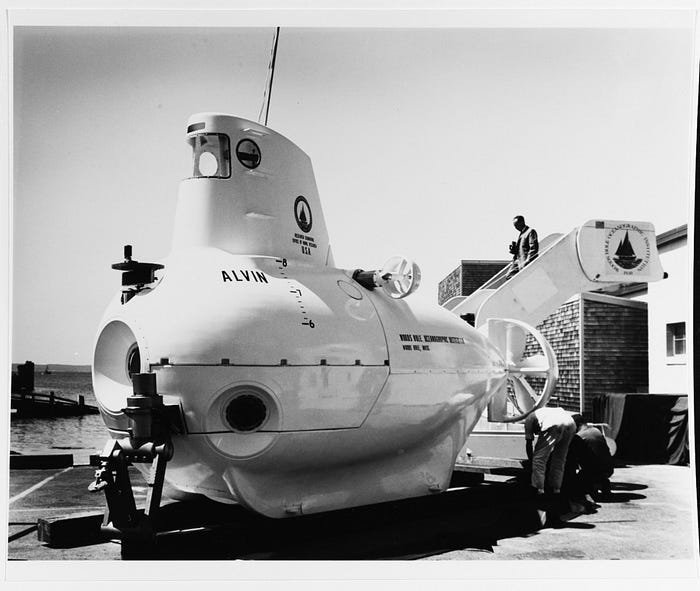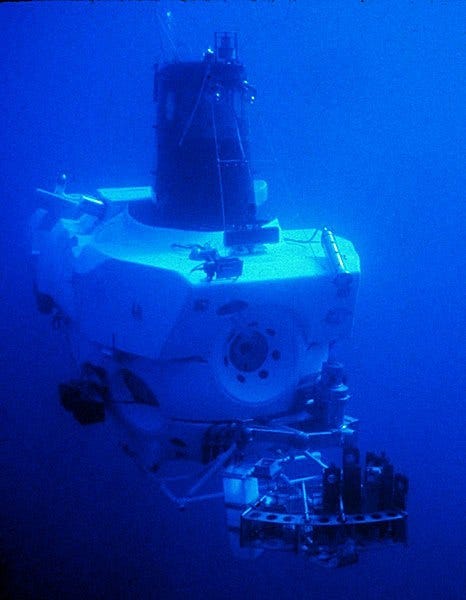It Was Built By A Cereal Company, And Changed The Way We See Life Forever
Taking Videos of the Titanic was only its third greatest achievement

“The Bureau of Ships was skeptical about a Wheaties company designing a submarine. They really didn’t want to see this precedent set.”
— Engineer at General Mills Harold Froehlich, via Minnesota Public Radio
There are times in your life when you hear strange stories and inevitably wonder whether they’re true.
This might be the greatest example of this in history. But it’s more. Within one story, there’s many, nested in loops that are hard to believe. Yet, the group is true.
It takes place in a realm we think we’re familiar with and as a society we exploit to our benefit: the ocean. As a resource, it’s staggering what it produces. Not to mention its size.
About ninety percent of all trade goes via ocean
Fish is the primary source of protein for almost three billion people in the world, and accounts for twelve percent of the world’s jobs
Seventy percent of the Earth’s surface is also covered by ocean
Despite its vast area, the volume of food it supplies, and its use as a trade highway, we don’t know much about it. In fact, oceanographer Gene Feldman claims we know more about the surface of the Moon and Mars than our oceans in an interview with NASA.
Mainly because deep water is harder to explore than space. Feldman notes pressure increases as you go down, visibility decreases, and the water gets terribly cold. He compares the pressure to the weight of fifty jumbo jets pressing on a human body.
Obviously, it presents a challenge. But you’d expect the largest organization sailing oceans across the globe would want to know more about the waters they operate in and what lies beneath. Well, that would be wrong.
Been There, Done That, Not Impressed
In 1958, The US Navy purchased the Trieste, a bathyscaphe (deep-water submarine), and hired its creator Swiss physicist Auguste Piccard. A few years later, they towed it to the deepest part of the ocean. The vessel dove seven miles down to the Mariana Trench and returned.
It was an amazing feat, as Bill Bryson in A Short History of Nearly Everything recounts. The submarine survived seventeen thousand pounds of pressure per square inch on its hull and raised and lowered itself without a cable. Not to mention they saw ocean life at this depth.
However, the navy wasn’t impressed. Bryson quotes a navy official as saying, “We didn’t learn a hell of a lot from it, other than that we could do it. Why do it again?” The head of submarines, Admiral Hyman G. Rickover also thought the Trieste was a big waste of money.
So, they ended the program. After an uproar from the scientific community, the navy put a bit of money on the side to build their own craft. But there was a problem. Most of the navy’s largest defense contractors weren’t interested.
Rickover’s skepticism and the funds going to the moon mission drew the primary candidates away.
In the end, General Mills won the bid in 1962. Yup, the breakfast cereal company. As you can imagine, the company that makes Cheerios and Wheaties designing a deep-water submarine might cause skepticism.
But there’s more logic to it than you think. You see, the General Mills of the 1960s wasn’t the same company you’re familiar with today.
Food Leads To Submarines
“In the late 1800s we were a flour milling company. We then began to figure out what we wanted to really be involved in, and that was food…Cheerios came out in the ’40s, but we were also figuring out, well, how do you make those? There’s a lot of great engineering and great process development that goes into that, and out of that came a mechanical division.”
— General Mills VP of R&D Lisa Schroeder, via Minnesota Public Radio
While food is the furthest thing from a submarine, it did lead General Mills into vastly different fields. Inevitably, you need machines to make it. Bill Catlin in his article for Minnesota Public Radio explains the company found itself branched into many endeavors.
For instance, they purchased a radio station to test out their marketing ideas, which included a cooking show for Betty Crocker.
Their expertise in machinery for making food equipment led to General Mills inventing the Ryan Flight Recorder, or the “black box,” which is consulted for flight data when planes crash. Their engineer Harold Froehlich even designed mechanical arms.

One of the arms was adapted for the Trieste. Suddenly, General Mills found themselves winning the bid for a submarine. They built the sub, called Alvin, in Minneapolis, and of course it had a mechanical arm. It could also move freely, more than just up and down.
This freedom of movement and ability to dive deep beyond the range of a normal sub gave Alvin incredible versatility, which the navy ignored. Well, until one day.
Alvin was stationed at the Woods Hole Oceanographic Institution in Cape Cod, Massachusetts, where a team of scientists field tested it to depths of seventy-five hundred feet. Not long after, the navy called with an emergency.
A Lost H-Bomb, And New Forms Of Life
In 1966, a B-52 bomber crashed into a flying fuel tanker, destroying both planes. While this is terrible, they also lost cargo.
This happened to be a hydrogen bomb with 1.1 megatons of explosive force, which fell somewhere in the ocean off the coast of Spain. Navy officers feared a real life versions of the James Bond movie Thunderball with bad guys picking an H-Bomb off the floor of the ocean.
Suddenly, the Navy brass remembered Alvin. They sent the sub into action, which was still in test phases, only being delivered two years before.
Conducting five dives a day at random points around a vast area, Alvin’s pilots eventually came across an odd shape wrapped in a parachute. It was the bomb. A few weeks later the navy recovered the device, mitigating a disaster with the help of the sub they never wanted.
Alvin kept finding interesting things after this as well. An overhaul in the 70s allowed it to reach depths of twelve thousand feet, so it could explore the ocean bottom. Between 1977 and 79 the sub visited the Galápagos Rift, and its discovery changed our view of life forever.

Alvin’s crew found chemosynthetic life. In other words, these are creatures that didn’t need the sun to live. A collection of giant tube worms and clams lived by energy captured from heated vents in the earth, having no access to sunlight.
Now, the search for life on Earth, and in the universe has changed scope dramatically. Bryson in his book also notes Alvin solved another riddle. Why doesn’t the ocean become overloaded with salt to the point where nothing can live?
We all know water evaporates. Well, in the ocean when this happens, salt is left behind. So why doesn’t it continuously build to a critical point? Those same undersea vents also act like pool filters, sucking out the salt and blowing out clean water. As Bryson explains:
“The process is not swift; it can take up to ten million years to clean an ocean. But it is marvelously efficient, as long as you’re not in a hurry.”
Oh yeah, and then there was that whole Titanic thing.
Landing On The Deck Of The Titanic
“The Titanic lay in two pieces about a mile apart. We were headed for the bow section. It is more than 400 feet long and standing right-side-up with a slight list to port, maybe 5 degrees. After driving away and getting an all clear from above, I turned Alvin to face the wreck…The Titanic was the biggest sonar target I had ever seen. It more than filled the screen.”
— William Sellers, Woods Hole Oceanographic Institute (WHOI) Website
William Seller, a pilot for Alvin, tells the incredible tale of the sub’s visit to the wreck of the Titanic in 1986 from a first-person point of view. In fact, it might be the greatest fishing story of all time.
Not only did they film the ship, but landed on the wreck itself, sending a small drone, called Jason Jr., with a camera into the interior of the ship.
Seller describes navigating the eighteen-ton sub around the monstrous rusting hulk in poor visibility with a team of three crammed inside. He tells a surreal tale in simple words:
“I hopped the sub up over the rail and set it down on the forward end of the starboard lifeboat deck, facing aft. Secure in our parking spot with all systems go, it was time for Martin to go to work and deploy Jason Jr…When Jason Jr. turned around, the whole distance between us was illuminated. We could see more than 100 feet. We even saw Alvin sitting there on the lifeboat deck in J.J.’s video. As well-lit as it was, the effect was spooky; for every thing they illuminated, they created as many shadows.”
Seller explains some of the windows were still present on the sides of the Titanic and so clear, the drone bumped into them. He recounts seeing a pommel horse through one. They’d found a gym.
On another dive, Seller anchored Alvin to a side railing, and from their perch sent the drone into a hole through the top of the wreck. Jason Jr. descended the remains of a staircase where no human had been in eighty years. Alvin’s team spent days investigating the wreck.
Each dive was filled with firsts and enough moments to fill a memoir. Although this is only one tale of Alvin’s work.
A Lifetime Of Exploration

As of 2021, Alvin has conducted more than five thousand dives, spending over thirty-five thousand hours under the ocean. It found H-bombs, discovered forms of life science never thought possible, figured out ocean riddles, and sat on the Titanic’s decks.
Not bad for a machine its purchaser didn’t want, built by a cereal company.
It’s also one of those strange stories in history, which sound more like fiction than fact. Moreover, it’s not finished. Alvin is still on the go, and no telling what chapters are left to add to this story.
-Originally Posted on Medium 12/11/22


